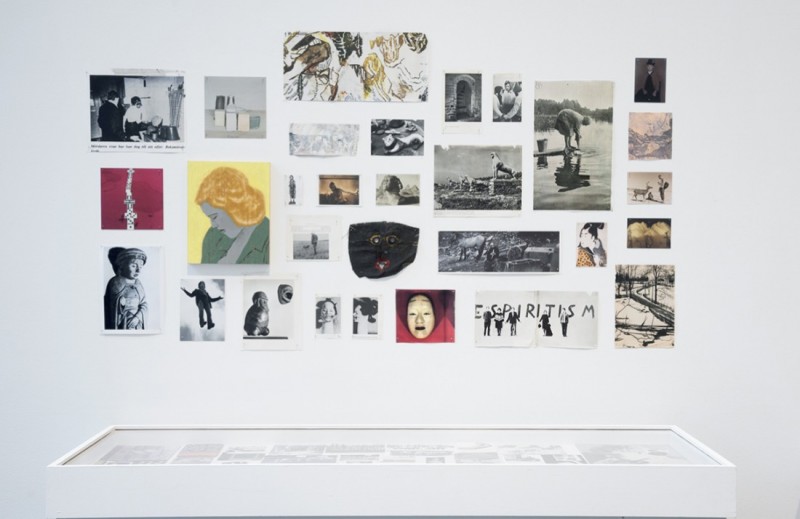Mamma Andersson
I have a habit of surreptitiously scanning the shelves, upon entering a room full of books. The goal of my innocent snooping is an attempt to gain insight into the person’s inner life, their likes and dislikes, references and desires. A kind of biblio-voyeurism.
What can we glean from someone’s taste in books? Mamma Andersson puts her library on full display in the monograph Memory Banks, published in conjunction with her recent solo exhibition at the Contemporary Arts Centre in Cincinnati. Nestled on her shelves are books on Japanese interiors, Kurt Cobain, dolls and dollhouses, contemporary dance, Holbein and Klimt. What I have concluded from a glimpse of Andersson’s books is that she is an artist who particularly loves collecting images. This archive is featured heavily in her paintings.

Mamma Andersson, Who is Sleeping on my Pillow, 2010, acrylic and oil on panel, 72 x 122 centimetres. © Toni Walsh. All images courtesy the Contemporary Art Center, Cincinnati, and David Zwirner, New York.
Studio shots give further insight into the origins and inspirations of her work. Reproductions of past paintings are pinned to the wall. Among them are a porcelain figurine cut out from a textbook, a photo of Jackie Kennedy and JFK sitting in a diner booth looking glum, postcards and black and white Polaroids you might find at an antique store in a cigar box and sold for a dollar. The anonymity of antique-store photographs replicates itself in Andersson’s paintings, resulting in narratives clouded in mystery. They are tiny tableaux, from which the viewer naturally fabricates an incomplete narrative. The fact that Andersson might also have limited information about the origins of the reference material is imbued in the work.
By considering her source images, we can better understand her paintings. Pastiches of historical and photographic references, various images blended together in a collage and translated in oil create paintings that are an extension of the New Figuration period. A term penned by French critic Michel Ragon, “New Figuration” refers to the revival of figurative work in the ’60s in Europe and America following a long period of abstraction. The multi-figure pieces forfeit genre in lieu of work that mixes interiors, still lifes and portraits. The paintings feel as if they are an accurate depiction of life as it is, with hints of supernatural or magical elements. Andersson’s contemporaries in the New Figuration movement include Leon Golub, David Hockney and Peter Doig.
The sense of anonymity in her paintings culminates in a sense of eerie unease. In the painting About a Girl, nine women sit around a table drinking coffee. You, the viewer, make the tenth. Four of the women are looking directly at you, deer caught in the headlights. Perhaps you misspoke, said something déclassé, or walked into the room at an inopportune moment when the group was gossiping about you. All of this is to say the feeling of the painting is ominous. Beyond the flesh-coloured curtains lies a sparse and monochromatic landscape. On the wall are Japanese ink drawings. And Snow White.

Installation view, “Memory Banks,” 2018–2019, Contemporary Art Center, Cincinnati. © Toni Walsh.
So Long Salong makes up for its lack of figures with sculptures that invoke human-adjacent forms. The painting is of an empty art gallery. Room dividers double as portals into other rooms in the gallery. The entire room is duplicated on the main wall of the gallery as if the wall were a large mirror. This dizzyingly funhouse effect reminded me of Playtime, a film by Jacques Tati. In an iconic scene from the film, the main character looks down at repeating rows of cubicles, not unlike the repeating walls in Andersson’s painting. Even Andersson’s palette seems copied from the film; both are filled with cold greys and seafoam greens. Her penchant for appropriating preexisting images is having its effect and I’m starting to make connections where maybe there are none.
The exhibition “Memory Banks” was curated by Kevin Moore, the artistic director and curator of FotoFocus, an organization based in Cincinnati that supports the medium of photography through a biennial, symposiums and shows. The curatorial connection to FotoFocus only further propels a hypothesis of the high standing that Andersson gives photography in her work. But it’s not just photography that Andersson is interested in. It’s all forms of reproduction. This is seen with her use of printmaking and its influence on her painting. The painting Rooms Under the Influence uses a relief print technique to transfer a painted image in reverse and creates a smudged, hazy quality. This ethereal effect is fitting in Andersson’s work (she uses this kind of mono-printing often, including the mirrored wall in So Long Salong). In this particular three-panel painting, the top panel is a pastoral landscape; the middle, an apartment in which we can see each room. The bottom panel is comprised of the top two, a physical impression of the above scenes. Leaning towards reading it as abstraction, Rooms Under the Influence challenges our understanding of interior/exterior, a confrontation that can easily be applied to the interior/exterior lives that Andersson so often plays with in her work. Andersson’s paintings often lean to the self referential, using images as models. She paints still lifes of stacks of books, framed photographs and paintings hung on walls. I read that poet Anne Carson never throws out any paper she’s written on, a preemptive archive of her life and work. Andersson is similar: she thrusts her archive of images and papers into permanency through the act of painting, one of the least ephemeral of media.
“Memory Banks” was exhibited at the Contemporary Arts Centre, Cincinnati, OH, from October 5, 2018, to February 10, 2019.
Tatum Dooley is a writer based in Toronto. Her work has appeared in Aperture, Canadian Art, The Globe and Mail, Real Life Magazine, The Walrus and others. She is a contributing editor at The Site Magazine.

